Welcome to this post about my productivity system in 2022!
I consider myself a fairly productive person. I go to high school, get good grades, own my own businesses, write blog posts, and spend a lot of time with friends and family.
I don’t procrastinate very much, I’m not lazy, and I almost always feel motivated to work. Once I tell myself I’m going to do something, I do it. There’s no quitting.
I don’t say all of this to brag. I say this because I want to build my credibility before we dive into the topic of my productivity system. Because, I wasn’t always this productive, I used to be a lot more lazy. It was this system that I have built over the last year that has really changed my life.
This system is unique to me, however there are parts of it that other people do as well. My system won’t work entirely for you. I hope parts of it do, but I know that a lot of people don’t operate like I do.
So without further ado, let’s get into my productivity system!
My Backstory
But before we do, I think it’s important to talk a little bit about my background, particularly when it comes to productivity.
I’ve always been a good student that got my work done and got good grades. I’m insanely motivated when it comes to school, but I know a lot of people aren’t. Other than school, I really didn’t have a lot going on outside of school until recently.
Up until high school, I would come home most days, do homework, play videos games, watch TV or Netflix, hang out with family, and then go to bed. There wasn’t a lot of productive things happening between when I got home from school and when I went to bed.
100 Days of Sweat
I’m writing this post on June 10, 2020. Exactly one year ago on June 10, 2019, I started the 100 Days of Sweat Challenge. This challenge was introduced by the YouTube channel, Yes Theory, and I decided to join. The challenge is simple, do something that makes you sweat everyday for 100 days straight.
I would consider this the moment that my self-improvement journey began. It started with just those workouts, but the motivation and discipline carried over to several other areas of my life as well.
Summer of 2019
As I progressed through 100 Days of Sweat, I went through a series of other moments/experiences that made me feel motivated to improve other areas of my life. I started thinking a lot about the areas of my life that I wanted to improve, and by the end of July, I was ready to make a drastic change.
The idea was simple, I wanted to build some habits and pursue some goals that I had. I wanted to quit wasting time on video games, Netflix, and my phone and instead work toward my goals.
One of those goals was to start a blog. So on July 28, 2019, I launched Teen Financial Freedom, the blog you are on right now! I went on to start several other businesses and really started to lock down the habits that I wanted to have in my life.
Before I tell you the exact productivity system that I use currently, I want to share with you some things I have learned along the way about productivity systems.
Productivity System Must-Haves
Eliminating Distractions
I think the first thing you must do when creating a productivity system is eliminate the distractions in your life.
Each day you get 24 hours and you are in charge of how you spend those hours. Currently, you probably are filling the majority of those hours with distractions.
I’m talking social media, video games, Netflix, TV, etc. These aren’t bad things, they are great for enjoyment. But, just like anything in life, there must be a balance.
If you want to be more productive, than you need to eliminate/cut down on the time you spend on unproductive things, such as the distractions listed above. Otherwise, you won’t have the time you need to spend on productive things.
How can you eliminate these distractions? Well for this example, I will be using Clash of Clans, a game I used to play a lot on my phone. The first thing I did was take a break from it. I decided to delete the app for awhile cause if the app was installed I knew I would accidentally check it. While I was on my break, I realized that I felt way more productive and that I really didn’t need to play it anymore.
That’s one option. The other option is to learn how to control the time you play on it. The best way to do this is to set your phone in another room while you are working on something. This goes for anything you want to stay away from on your phone, social media, texting, video games.
Either take a break, quit entirely, or find a way to cut down usage. Those are your three options.
Balance
As I briefly touched on earlier, there is a balance with this. I don’t think anyone should complete cut out all social media, video games, Netflix, or TV.
These are great sources of enjoyment, and relaxation. If you spend too much time on this stuff you won’t be productive. But, if you don’t spend enough time on this stuff, then you will get burned out.
The trick is to try to spend a few hours each day being productive. I shoot for 4-6 hours. Then the rest of the day I spend with friends or family or I relax with one of the items above. This keeps me productive, but also keeps me from getting burned out.
The other thing that is important to balance is the amount of things you are trying to do once. Last fall I got into the situation where I was trying to work on 5+ businesses at the same time. That is just not doable.
I feel like everyone eventually hits this stage in the self-improvement journey of trying to do too much. You go from not doing anything productive to then doing too much at once.
I would advise people to start slow, and really put a lot of effort into a few things. For example, I now have 4 areas in my life that I work on, my personal life, this blog, freelancing, and my t-shirt business.
I think 3-4 areas is the sweet spot, because you can spend 10+ hours a week working on each, and still have time to relax.
This also goes for habits. When I first started building habits, I tried to build 14 at once!!! 14! That is way too much and now I currently have it down to 6 habits that I am trying to build.
Habit Tracking
Speaking of habits, I think it is important to do habit tracking when you are trying to build habits.
It might just be because I’m kind of a nerd, but I think that this data is fascinating. I track my habits along with a few other stats and I love being able to look back and analyze how things went.
It is also very satisfying to check off the habit after you do it. It makes you feel accomplished and motivated to do more.
Setting Goals and Dividing Them
Once you got the first 3 things down, I think the next step is setting goals and breaking them down into smaller actionable steps.
This is where you should list every aspect of your life you want to improve, then use the acronym SMART to set your goals. If you’re unfamiliar with SMART, this is what it means:

I think the most important ones to follow here are making sure your goals are measurable and time-bound. Without these, there’s no way to track progress and no deadlines.
After you have set your goals, you need to break them down. I would recommend first setting goals for the next year. Then, break them down into months. What do you have to do each month to stay on track to achieve your goals.
Then, each month, divide your goals for that month across each week. If you have 4 big projects to do this month, then devote one week to each project.
Finally, each week, spread your weekly goals out across each day. Put the most important things at the beginning of the week so you can make sure they are done on time. Don’t put too much on one day, like I said, I would recommend being productive for 4-6 hours each day.
Creating To-Do Lists
These daily items become your to-do lists. I know that a lot of people don’t like to-do lists, but they are essential to productivity system.
Without them I might forget what all I have to do that day or I might not go about my tasks in the most efficient way.
Most of all, I love the feeling of checking something off of my to-do list once I complete the task. It’s the most satisfying feeling in the world.
If you don’t like to-do lists, I would encourage you to give one a try again. I truly believe they are essential to productivity.
My Productivity System
Now that we have finally gone through my backstory, everything that I have learned, and the productivity system must-haves, I think it’s finally time to tell you what my productivity system looks like.
Phase 1 – Idea Inbox
The first phase to my system is my idea inbox. This idea comes from Pete form Do You Even Blog.
The concept is simple, create an idea inbox note on the notes app on your phone. Then, anytime anything pops into your head that might be important or that you want to remember or later, write it down in this idea inbox.
It helps a ton with mental clarity. This way, you can have the idea, write it down, and forget about it. I remember before I started doing this I would always be struggling to remember things. Now, I have almost nothing in my life to remember that isn’t written down somewhere.
Then, each week, I take a look at each item and find a way to deal with it. This is done in a few ways. The first option is to take care of it immediately. This is usually done for tasks that take 10 minutes or less. If it takes longer than that, I add it to my weekly to-do list for the following week. If it’s a big idea or something that isn’t happening soon, I write it down in my calendar or somewhere else where I will remember it at a future date.
The important thing here is to remember that this is an inbox, not a storage facility. So empty your inbox using one of the methods mentioned above, or just delete the things you don’t need anymore. This keeps it clean and simple and much more easy to manage.
Here’s a picture of what my idea inbox looks like:

Phase 2 – Bullet Journal
The next step in the process is my bullet journal, and this my friends, is a game changer. This is where I set my goals, divide them, and track my progress.
It all starts with my goals for the year that I write in the beginning of the bullet journal. I write my goals for all the areas of my life that I want to improve.
Then, I divide them into my ‘Future Log’ which just has a section for each month where I try to place each one of these yearly goals. I place the goal either in the month where I should start that goal or the month when the deadline for that goal is.
Each month, I look at my goals for that month and divide them into weeks. I have a separate page for each new week, and each week has it’s own to-do list. This is where I start to make my goals very actionable (specific, not broad).
I usually shoot for 3-5 items for each of the 4 categories I work on, personal, this blog, freelancing, or my t-shirt business. This means that I usually average 10-20 to-do list items per week in total.
The final step is divide the tasks among the days of the week, shooting for 2-3 tasks per day. Sometimes I end up with 5 tasks per day, but those tasks are quick and easy. The majority of the tasks on my list take around 2 hours. So if each task takes 2 hours, and I do 2-3 tasks per day, I’m right on schedule for working 4-6 hours a day.
Here’s a picture of what my bullet journal looks like:

Phase 3 – Google Calendar
To divide my tasks among the days of the week, I use Google Calendar. I don’t really make daily to-do lists because the calendar acts as my to-do list. I put everything on here: events, school assignments, workouts, to-do list items, business stuff, family time, friend time, etc.
So each day, when I wake up, I have everything that I need to do that day right there in front of me on my calendar.
I use Google Calendar for a few reasons. The first of which is because it syncs across all of my devices, making it easy to view it anywhere at any time. The next reason is because it is clean, organized, and looks visually pleasing. You can color-code tasks based off of the category they are in. The final reason is because it is easy to move tasks from one day to another. You can drag an item to a separate day in less than a second which is great fo those with a flexible schedule.
As I was mentioning earlier, I look at my weekly to-do list and then add those tasks to my calendar. I place the most important tasks at the beginning of the week to make sure they are done on-time. I try to batch certain tasks together if they are related. I try to spread big projects out across multiple days. Finally, I remember other obligations that might keep me from getting work done on certain days, and I avoid scheduling anything for those days.
Here is a picture of what my calendar looks like:

The Takeaway
That’s it! I hope you enjoyed this post! That’s my productivity system that I used to accomplish my goals. If you’re looking for a way to be more productive, I highly recommend buying this Wordsworth planner. It is a weekly and monthly planner to help increase productivity and time management and hit your goals. You can use this planner as an organizer or as a business or gratitude journal. hope that you can take something away from this post and apply it to your own life and your own system.
